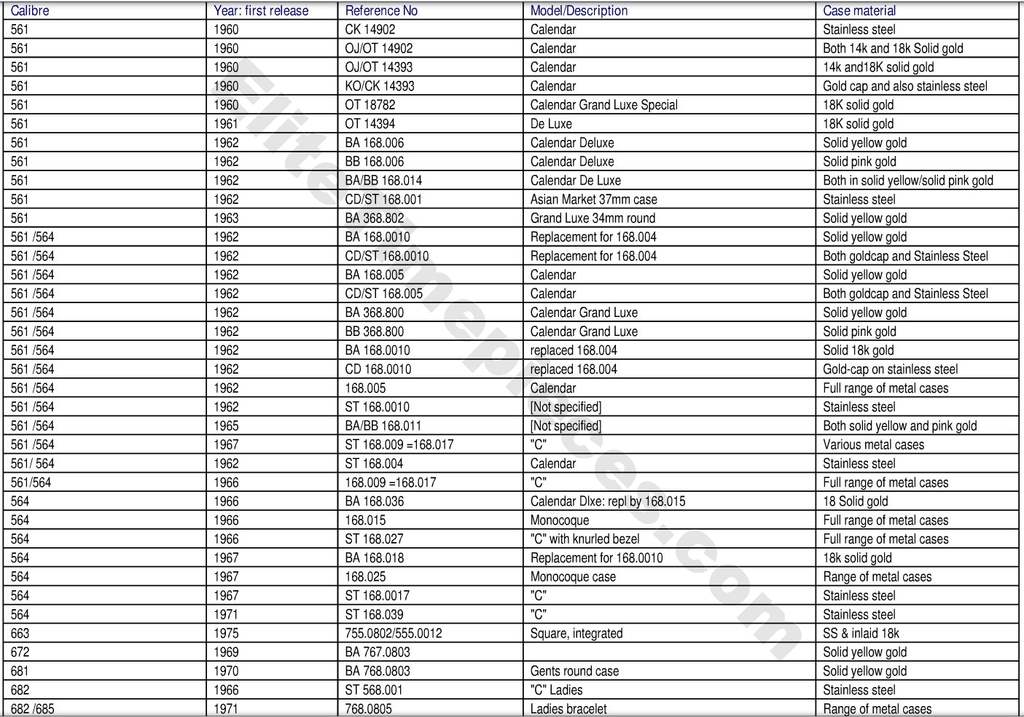Omega Serial Numbers

These cookies record information about choices you make on the Website, such as your user name, language or the region you are in. In this way, we are able to personalize your visit to the Website. These cookies allow us to collect information about how visitors use the Website, for example to count visitors and to see how visitors move around the Website. They record your visit to the Website, the pages you have visited and the links you have followed.
These cookies do not collect information that identifies you. All information is anonymous. This helps us to improve the way the Website works. Applied differential equations pdf.
ABOVE: Around 2005, Rolex started engraving the Case's Serial Number into the inside edge of the case (at the 6 o'clock position, under the crystal and below the bezel), also known as the rehaut, as shown in these images, which were taken at BASELWORLD 2005, in Switzerland in early April. BELOW: A close-up view of the same watch, you can clearly see the Serial Number 'F982176', engraved into the case at the 6 o'clock position, with 'ROLEX' engraved repetitiously around the dial in a circular fashion. In 1927, Rolex began issuing every Rolex Oyster case a unique serial number to distinguish them from one another. This numbering system was originally believed to have started at 20,000, however earlier numbers have surfaced shooting holes in this theory. Around 1953, the numbers reached the 999,999 mark, at which time Rolex decided against adding a 7 th digit, thus continuing into the 'millions'--Instead, they started the sequence over. While it was originally believed that this resequence started over at 100,000, or even 20,000, but evidence suggests that it actually restarted at 10,000 or possibly lower. Around this same time, Rolex had initiated another dating system--They stamped the inside of the case back with a code consisting of a Roman numeral and two numbers.
Jul 19, 2018 - Omega Watches are no different, using an eight-digit serial number that identifies the model, materials and year. Each component of the eight. Older Omega watches may only have the serial number on the inside of the watch, requiring a quality jewellery or watch repairer to open it. More Modern watches have the laser engraved usually on the back of your watch.
The Roman numerals were I, II, III, IV, which represented which quarter of the year the watch was produced. The numbers simply represented the two-digit year in which the watch was produced. Therefore, the code 'III 53' would represent the 3 rd quarter (i.e. July-September) of 1953--this code continued until around 1970. Please note, some examples (primarily from around 1959), did feature the Roman Numeral and a 4-digit year (i.e. In the early 1960s, Rolex once again reached the 999,999 mark, but this time added a 7 th digit and continued into the 'millions' until mid 1987, when the numbering reached 9,999,999. At this time, Rolex elected to start numbering with a letter prefix (e.g.
The system started with the letter 'R', whcih was then subsequently followed by L-E-X. Thus spelling out the word 'ROLEX' with the 'O' being omitted, to help avert any possible confusion with the number '0'. This sequence continued through November 1991, when a new numbering system was introduced utilizing the letters N, C and S, which took them through 1993.
In 1994, Rolex started yet another sequence with the letters: W, T and U, then A, P, and K in subsequent years, followed by Y, F, D, Z, M, V and then G in 2010. Please note, during the 1990s and 2000s, it is estimated that Rolex produced around around 1 million watches per year.
Coincidentally, the numbering sequence of any particular Letter from this system (e.g. V000001 to V999999), would in fact also be 1 million serial numbers, and worked well with this system. It is worth mentioning that Rolex would not cease a letter prefix run at the end of a given calendar year, but would continue a letter run until all numbers were used before changing the prefix code.
Therefore, letter prefixes could end at random times of the year, and did not start or stop at the beginning or end of a calendar year. Then, later in 2010, they scrapped the entire system and implemented a brand new 'Random' numbering system, in which each watch is issued a (unique) 8-digit 'Random' number consisting of numbers and letters. An example of this number would be something like '16G9L7F4' and could start with either a letter or number.
This offers them a seemingly endless numbering system by which they could continue indefinitely. Figuring 8 digits with a possible 36 characters (26 letters and 10 numbers) per digit, gives them over 2 Trillion (2,821,109,907,456 to be exact) possible serial numbers. Even if they were to omit the letters 'O' and 'I', to help avert any possible confusion with the numbers '0' and '1' (as they did in the previous numbering system), that would still give them 1,785,793,904,896 possible combinations.